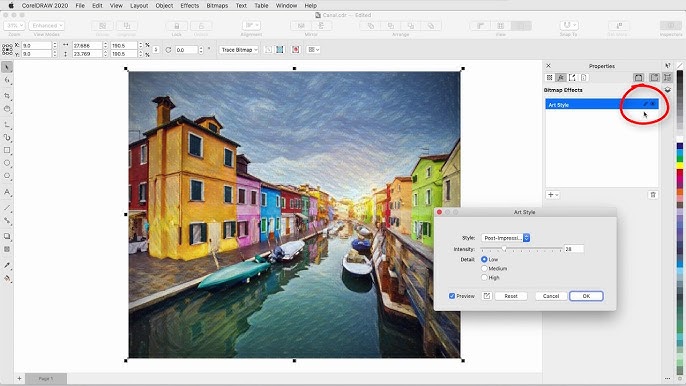Mastering Visual Alchemy: An In-Depth Exploration of Using Masks in Corel PHOTO-PAINT™

Introduction
In the realm of digital image manipulation, Corel PHOTO-PAINT™ stands as a powerful alchemical laboratory where visual transformations come to life. Among its arsenal of creative tools, the use of masks emerges as a dynamic technique, allowing artists and photographers to sculpt, blend, and refine images with unparalleled precision. This comprehensive guide embarks on an in-depth exploration of using masks in Corel PHOTO-PAINT™, unraveling the intricacies of this transformative feature. Whether you’re a seasoned digital artist or a newcomer to the world of photo editing, this guide will equip you with the knowledge to harness the full potential of masks and elevate your creative endeavors.
Understanding Masks in Corel PHOTO-PAINT™
1. Defining Masks:
- In the context of Corel PHOTO-PAINT™, a mask is a grayscale image that defines the transparency of corresponding pixels in the original image. White areas of the mask are fully opaque, while black areas are fully transparent, creating a spectrum of opacities in between.
2. Types of Masks:
- Corel PHOTO-PAINT™ supports various types of masks, including layer masks, object masks, and alpha masks. Each type serves a specific purpose, providing users with a versatile toolkit for image manipulation.
3. Non-Destructive Editing:
- One of the strengths of using masks is the non-destructive nature of the edits. Masks allow users to make adjustments without permanently altering the original image, providing flexibility and the ability to revert to the original state at any time.
The Power of Layer Masks
1. Layer Mask Basics:
- Layer masks in Corel PHOTO-PAINT™ are associated with specific layers and control the transparency of the entire layer. By painting on the layer mask, users can reveal or conceal portions of the underlying image.
2. Gradient Masks:
- Gradient masks enable smooth transitions between opaque and transparent areas. This technique is particularly useful for creating gradual fades, blending effects, or simulating lighting conditions in an image.
3. Channel Masks:
- Channel masks allow users to isolate specific color channels (red, green, or blue) to create selective adjustments. This technique is invaluable for fine-tuning color balance and enhancing specific color components within an image.
Unleashing Creativity with Object Masks
1. Object Mask Fundamentals:
- Object masks are applied directly to specific objects within an image rather than an entire layer. This targeted approach offers precise control over the transparency of individual elements within a composition.
2. Combining Object Masks:
- Layering multiple object masks allows for complex compositions and seamless blending of various elements. This technique is particularly effective in collages, photomontages, and composite artworks.
3. Soft Edges and Feathering:
- Utilizing soft edges and feathering in object masks results in smoother transitions between opaque and transparent areas. This technique is essential for achieving realistic and seamlessly integrated compositions.
Alpha Masks: Fine-Tuning Opacity
1. Alpha Mask Essentials:
- Alpha masks function similarly to layer masks but are applied to the entire image rather than a specific layer. These masks serve as a global control for adjusting the overall transparency of the image.
2. Refining Transparency with Brushes:
- Corel PHOTO-PAINT™ provides a variety of brushes that can be used directly on alpha masks to refine the transparency of the entire image. This allows for artistic expression and precise control over the visibility of specific areas.
3. Dynamic Edits with Quick Transparency:
- Quick Transparency tools enable rapid adjustments to alpha masks, providing a dynamic and responsive way to fine-tune the overall transparency of the image during the creative process.
Step-by-Step Guide: Applying Masks in Corel PHOTO-PAINT™
Step 1: Open Corel PHOTO-PAINT™ and Load Image
- Launch Corel PHOTO-PAINT™ and open the image on which you want to apply masks.
Step 2: Create or Load a Mask
- Depending on your editing goals, create a new mask or load an existing one. Corel PHOTO-PAINT™ provides options for generating masks from selections, channels, or external files.
Step 3: Apply Mask to Layer or Object
- Associate the mask with the desired layer or object. In the Layers docker, select the layer or object, and then choose the appropriate mask option.
Step 4: Refine Mask with Brushes
- Use the Brush tool to paint on the mask, revealing or concealing areas as needed. Experiment with different brushes, opacities, and brush sizes for precise adjustments.
Step 5: Explore Mask Effects
- Delve into the Effects menu to explore advanced mask effects. Experiment with options like Blur, Sharpen, or Distort to add creative and stylistic touches to your masked areas.
Step 6: Save Your Work
- Once you are satisfied with the applied masks and overall edits, save your work. Corel PHOTO-PAINT™ supports various file formats, ensuring compatibility with different platforms and applications.
Tips and Best Practices
1. Use Layer and Object Masks Complementarily:
- Combine layer masks and object masks strategically to create intricate compositions. Layer masks control transparency at the layer level, while object masks provide localized control within specific elements.
2. Experiment with Blending Modes:
- Alter the blending mode of a layer or object to interact with the underlying layers dynamically. Blending modes offer versatile ways to integrate elements seamlessly and achieve unique visual effects.
3. Master Feathering Techniques:
- Practice feathering and soft edge techniques to ensure smooth transitions between masked and unmasked areas. This skill is crucial for achieving professional and polished results in photo manipulation.
4. Utilize Quick Transparency for Efficiency:
- Leverage the Quick Transparency tools when working with alpha masks for efficient and real-time adjustments. These tools streamline the editing process, allowing for rapid experimentation.
5. Save Mask Presets:
- Save frequently used masks as presets for future projects. This practice not only enhances workflow efficiency but also ensures consistency in editing across different works.
6. Embrace Layer Grouping:
- Group layers and objects logically to simplify the organization of your composition. Layer grouping enhances manageability, especially in complex projects with multiple elements and masks.
Conclusion
Using masks in Corel PHOTO-PAINT™ is akin to wielding a digital sculptor’s chisel, allowing artists and photographers to carve and shape images with precision and finesse. This comprehensive guide, enriched with insights into mask types, layering techniques, and practical tips, equips users to master the art of image manipulation within Corel PHOTO-PAINT™. Whether you’re aiming to seamlessly blend elements, selectively adjust colors, or create intricate compositions, the versatility of masks in Corel PHOTO-PAINT™ opens up a realm of creative possibilities. As you embark on your visual journey, let the application’s mask features be your accomplice, empowering you to transcend the ordinary and craft visual narratives that resonate with depth and artistic ingenuity.







